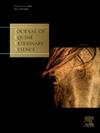Studies on conventional in vitro fertilization of in vitro-matured equine oocytes using fresh, or cool-stored stallion sperm
IF 1.3
3区 农林科学
Q2 VETERINARY SCIENCES
引用次数: 0
Abstract
Conventional in vitro fertilization (IVF) of in vitro-matured equine oocytes has been historically difficult. A recent study reported that prolonged incubation (∼ 22 h) of fresh stallion semen in a Tyrode's Albumin Lactate Pyruvate (TALP) medium supplemented with penicillamine, hypotaurine, and epinephrine (PHE) yielded high fertilization (> 75%) and blastocyst (up to 40 – 50%) rates (Felix et al., Biol Reprod 2022; 107: 1551 – 1564). Anecdotal and published data reported lower blastocyst production rates (3 – 5%) when using a similar sperm incubation system (Papas et al., Vlaams Diergeneeskundig Tijdschrift 2024; 93: 131 – 135). We compared the production of IVF-derived blastocysts when using fresh or cool-stored stallion sperm processed using the methodology described by Felix and co-workers. In all experiments, Cumulus-oocyte complexes (COCs) were recovered by transvaginal oocyte aspiration (TVA) and cultured for 30 – 32h to induce in vitro maturation; fresh or cool-stored (24h) sperm from a single fertile stallion was utilized; all COCs were co-cultured for 3 hours with sperm previously incubated in TALP-PHE; presumptive zygotes were cultured for 32h post-fertilization (post-IVF) in Global medium, denuded from cumulus cells and further cultured in Global until day 5 post-IVF; finally, from day 5 to day 10 post-IVF, cleaved embryos (i.e., > 8 blastomeres) were cultured in DMEM-F12 medium until a blastocyst developed. In Experiment 1, 122 COCs were co-incubated with fresh semen incubated for 22 h in TALP-PHE. At day 5 post-IVF, 74 of the COCs co-incubated with sperm did cleave (i.e., > 8 blastomeres; 60% cleavage rate), and 6 blastocysts developed between day 7 to 10 post-IVF (8% blastocyst production rate). In Experiment 2, 93 COCs were co-incubated with cool-stored sperm that was incubated in TALP-PHE for 22 h. At day 5 post-IVF, 36 of the COCs co-incubated with sperm did cleave (39% cleavage rate), and 4 blastocysts developed between day 7 to 10 post-IVF (11% blastocyst production rate). In Experiment 3, the sperm incubation time in TALP-PHE was reduced from 22 to 10 h. A total of 34 COCs were co-incubated with cool-stored sperm. At day 5 post-IVF, 23 of the COCs co-incubated with sperm did cleave (60% cleavage rate), and 6 blastocysts developed between day 7 to 10 post-IVF (26% blastocyst production rate). We were able to produce IVF-derived equine blastocysts under our laboratory conditions, although at lower rates than those previously reported by Felix and coworkers, while higher than those reported by Papas and coworkers. We reported for the first time the production of IVF-derived equine blastocysts using cooled-stored stallion sperm. Also, we report that a shorter (10 h) sperm incubation time in TALP-PHE yielded IVF-derived blastocysts. Additional studies are required to conclude the repeatability of conventional IVF in equine oocytes using cooled-stored sperm incubated for shorter time in TALP-PHE, as well as differences between stallions when utilizing this IVF system.
求助全文
约1分钟内获得全文
求助全文
来源期刊

Journal of Equine Veterinary Science
农林科学-兽医学
CiteScore
2.70
自引率
7.70%
发文量
249
审稿时长
77 days
期刊介绍:
Journal of Equine Veterinary Science (JEVS) is an international publication designed for the practicing equine veterinarian, equine researcher, and other equine health care specialist. Published monthly, each issue of JEVS includes original research, reviews, case reports, short communications, and clinical techniques from leaders in the equine veterinary field, covering such topics as laminitis, reproduction, infectious disease, parasitology, behavior, podology, internal medicine, surgery and nutrition.
 求助内容:
求助内容: 应助结果提醒方式:
应助结果提醒方式:


